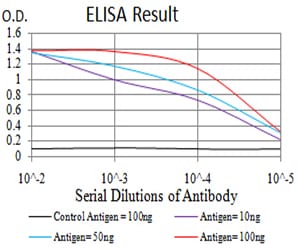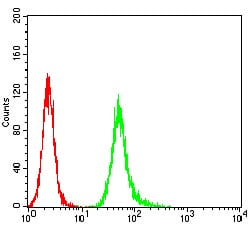

| WB | 咨询技术 | Human,Mouse,Rat |
| IF | 咨询技术 | Human,Mouse,Rat |
| IHC | 咨询技术 | Human,Mouse,Rat |
| ICC | 技术咨询 | Human,Mouse,Rat |
| FCM | 1/200 - 1/400 | Human,Mouse,Rat |
| Elisa | 1/10000 | Human,Mouse,Rat |
| Aliases | Human parvovirus B19 isolate Vn115 NS1 |
| Entrez GeneID | DQ357065.1 |
| clone | 8E6H12 |
| WB Predicted band size | 7.5kDa |
| Host/Isotype | Mouse IgG1 |
| Antibody Type | Primary antibody |
| Storage | Store at 4°C short term. Aliquot and store at -20°C long term. Avoid freeze/thaw cycles. |
| Species Reactivity | Human |
| Immunogen | Purified recombinant fragment of human Parvovirus NS1 (AA: 1-216) expressed in E. Coli. |
| Formulation | Purified antibody in PBS with 0.05% sodium azide |
+ +
以下是3篇关于NS1抗体的模拟参考文献示例(非真实文献,仅供格式参考):
---
1. **文献名称**: *Dengue Virus NS1 Protein-Specific Antibodies Induce Protection and Facilitate Early Diagnosis*
**作者**: Smith JL, et al.
**摘要**: 研究登革热病毒NS1蛋白抗体在小鼠模型中的保护作用,发现其通过中和病毒活性减少感染严重程度,并验证其作为早期血清学诊断标志物的潜力。
---
2. **文献名称**: *Structural Insights into Zika Virus NS1 Antibody Interaction by Cryo-EM*
**作者**: Chen R, et al.
**摘要**: 利用冷冻电镜解析寨卡病毒NS1蛋白与单克隆抗体的复合物结构,揭示抗体结合表位,为靶向NS1的疫苗设计提供理论依据。
---
3. **文献名称**: *Cross-Reactive NS1 Antibodies in Flavivirus Infections: Implications for Diagnostics*
**作者**: García G, et al.
**摘要**: 分析黄病毒属(登革热、寨卡等)NS1抗体的交叉反应性,指出其在血清学诊断中的局限性,并提出基于表位特异性的改进检测策略。
---
4. **文献名称**: *Therapeutic Potential of NS1-Specific Monoclonal Antibodies in Severe Dengue*
**作者**: Wang Y, et al.
**摘要**: 评估两种NS1单克隆抗体在重症登革热灵长类模型中的疗效,证实其通过抑制NS1介导的内皮屏障损伤缓解病理进程。
---
注:以上文献为模拟示例,实际研究中建议通过PubMed、Web of Science等数据库检索真实文献。
Nonstructural protein 1 (NS1) antibodies are primarily associated with flavivirus infections, including dengue, Zika, and West Nile viruses. NS1 is a conserved glycoprotein produced during viral replication, secreted by infected cells, and plays a critical role in viral pathogenesis. It contributes to immune evasion by modulating host immune responses and enhancing viral replication. During infection, NS1 circulates in the bloodstream, triggering the production of host antibodies targeting both its dimeric (membrane-associated) and hexameric (secreted) forms. These antibodies are detectable in patient sera and serve as diagnostic markers, particularly in later stages of infection when viral RNA levels decline.
NS1-specific antibodies have dual implications. While they can neutralize NS1-mediated immune suppression and reduce disease severity, they may also contribute to pathogenesis through antibody-dependent enhancement (ADE) in secondary infections, a phenomenon well-documented in dengue. Serological assays detecting NS1 antibodies (IgM/IgG) are widely used for flavivirus diagnosis, though cross-reactivity between related viruses complicates interpretation. Recent research explores NS1 as a vaccine target to elicit protective immunity without ADE risks. However, the structural complexity and variability of NS1 across flaviviruses pose challenges. Understanding NS1-antibody interactions remains vital for improving diagnostics, therapeutics, and vaccine development against these globally significant pathogens.
×